The collection at Fort Stanwix National Monument contains nearly 500,000 objects. These include objects, archives, and artifacts from at least 3,000 years of history! Learn about some of the more ancient, unusual, and unique ones from the time of the Oneida Carry in this series of “Curious Collections.”
-
Fort Stanwix National Monument
Article 1: Archaic Brewerton Projectile Point
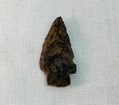
This Brewerton corner-notched projectile point was recovered during the 2003 archeological excavation that preceded the construction of the Willett Center. Dating to the Archaic period (9,000 – 3,000 BP), the point represents Native Americans’ use of the land around Fort Stanwix prior to contact with Europeans. Read more
-
Fort Stanwix National Monument
Article 2: Archaic Lamoka Projectile Point

Fort Stanwix was built upon a hill that had been visited by American Indians long before the arrival of the Europeans. These prehistoric visitors left behind no written evidence, but only artifacts of their culture beneath the ground. When archaeologists excavated Fort Stanwix in the 1970’s, they discovered these sparse clues in addition to the historic fort. Read more
-
Fort Stanwix National Monument
Article 3: Jesuit Ring

This heart-shaped ring was one of thousands used for trade, gifts, and religious purposes as French missionaries, explorers, and merchants spread through North America. They are often found in locations where the French and native cultures came together; areas like the Oneida Carry. Read more
-
Fort Stanwix National Monument
Article 4: Roseboom Ledgers

Spanning nearly 20 years during the mid-18th century, the pages provide a glimpse into the Roseboom's military, trade, and personal experiences with the people they encountered between 1757 and 1775. Read more
-
Fort Stanwix National Monument
Article 5: King of Prussia Plate

The collection at Fort Stanwix National Monument contains nearly 500,000 objects! This plate is unique to the time period of the British occupation and was discovered by NPS archeologists during the 1970s excavation of the fort. Read more
-
Fort Stanwix National Monument
Article 6: British Half Penny

The collections at Fort Stanwix National Monument contains nearly 500,000 objects! This coin is just one of them. When archeologists found this British half-pence (or half-penny), it was located in the remnants of a wood lined cellar of the British Barracks of Fort Stanwix. Read more
-
Fort Stanwix National Monument
Article 7: Grenadier's Match Case

This unique archeological find was misidentified upon its discovery in the remains of the historic Fort Stanwix. It tells the story of elite British soldiers but its owners are unknown. Read more
-
Fort Stanwix National Monument
Article 8: Escutcheon Plate
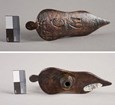
The collections at Fort Stanwix National Monument contains nearly 500,000 objects! This portion of an British musket is just one of them. It was uncovered by archeologists in the Sally Port of Fort Stanwix during excavations in the 1970s. Read more
-
Fort Stanwix National Monument
Article 9: The Mystery of Object FOST 8998
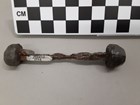
Just what is object FOST 8998? Is is a type of military ammunition? A nail? And what was it used for? Learn a little bit more about this mysterious object here. Read more
-
Fort Stanwix National Monument
Article 10: Powderhorn
Powder horns were often decorated with engravings, many of which depict maps like the one seen on this powder horn. These maps usually provided a basic geography of an area. This powder horn shows the Hudson River from New York City to Canada. Read more
-
Fort Stanwix National Monument
Article 11: Mortar Bombs
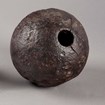
The collections at Fort Stanwix National Monument contains nearly 500,000 objects! This mortar bomb from the Siege of 1777 is just one of them. During the 21 day siege, British troops lobbed hundreds of 4.5 inch "Royal" mortars at the fort! Read more
-
Fort Stanwix National Monument
Article 12: Bone Buttons & Manufacturing Tool

These bone buttons, a cow rib bone from which buttons were cut, and the bit used to make them are poignant reminders that Fort Stanwix in the 18th century was the frontier and that in order to survive in such a place, you had to do things yourself. Read more
-
Fort Stanwix National Monument
Article 13: Spanish Coins

These Spanish coins found at the remains of Fort Stanwix/Schuyler would not have been used by conquistadors, nor anyone else of Spanish descent. Click here to find out why it would've been used in New York. Read more
-
Fort Stanwix National Monument
Article 14: Nicholas Herkimer's Field Desk

This field desk once belonged to General Nicholas Herkimer of the Tryon County Militia and could have been the desk he used in the days leading up to the ill-fated Battle of Oriskany. Read more
-
Fort Stanwix National Monument
Article 15: The 1st NY Orderly Book
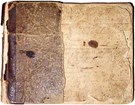
The Orderly Book of the 1st NY Regiment, a historic military journal related to the happenings at Fort Schuyler in 1778 and 1779, was donated to the park in the early 2000s. The following is the story of how this special artifact was preserved for future generations. Read more
-
Fort Stanwix National Monument
Article 16: Animal Bones

Thousands of animal bones were found at Fort Stanwix. Some were the remains of food, others livestock and pets. These are just a few examples. Read more
-
Fort Stanwix National Monument
Article 17: New 3D Technology Utilized for Preservation

Using 3D technology of the future, Fort Stanwix National Monument and Dr. Michael "Bodhi" Rogers to preserve the past. In June of 2018, a fireplace hearth, the only structure left visible from the original fort, became the first artifact scanned using this technique. Read more

